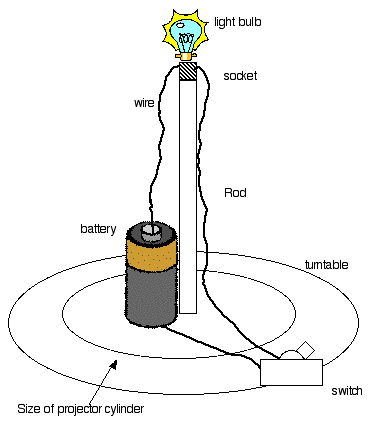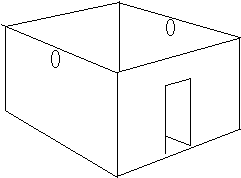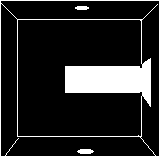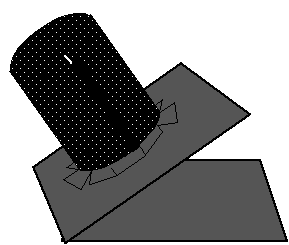Projector:
This project assumes you have already completed the Projector
Cylinder project,
and have it on hand.
Your objective here is to build a device that meets the following requirements:
- A small, bright light is suspended in the exact geometric center of the Projector Cylinder. The bulb should be replaceable in case it blows. The bulb should be as small as possible.
The entire apparatus should be rotatable along the long axis of the cylinder.
The entire apparatus should be able to tilt to different levels between 0 and about 45 degrees.
Light from the bulb should not illuminate the bottom of the cylinder, no matter what the orientation.
-The instructions here will achieve these goals:
| small bright light | Dowel rod |
| 6V latern batteries | Glue |
| screws | bulb socket |
| black paint | Coat hanger wire |
| Duct tape | Plywood |
1.
Cut a piece of dowel rod about a centimeter shorter than half of
the projector cylinder. Mount the light bulb socket to the top of
this rod by using glue, screws or any other convenient means including
duct tape if necessary.
2. Connect wires to the bulb socket. The wires
need to be longer than the dowel rod by several inches.
3. Connect the wires to the switch (if used)
or directly to the battery to test the light bulb function. 6V
lantern batteries last a long time and provide plenty of power.
If the bulb is rated at 6V, the light should be sufficiently
bright. If you have a switch, extend the wires outside the radius
of the projector cylinder so you can switch the light on and
off without removing the cylinder.
4. Attach the battery and light bulb assembly
to the lazy susan. One method is to run a screw through the bottom
of the turntable to the rod; if the enter of the turntable is
hollow, then you may need to duct tape the battery assembly to
the turntable or mount a piece of thin plywood on top of the
turntable.

5. Next, if you want your projector to block off
stars not visible because they are below the horizon, build this
device using a small plastic container and coat hanger wire.
You need a container larger than the light bulb and smaller than the projector
cylinder.
Cut a slot out of the
container which starts in the bottom, goes out to the edge, and goes most of
the way up the side. The slot should be wider than the
rod and wire assembly. Pierce two holes on the sides of the container on either
side of the container, near the top. 
Note: The small holes should be centered
on the sides, but the bottom slot should extend past the middle enough
to clear the central dowel rod.
6. Paint or color the interior surface of the
container black.

7. Bend a piece of coat hanger wire so that it acts as a support for the box. Begin by making an arm support for one side, then wrap the coat hanger around the dowel below the level of the box. Bring the wire up to the other side and use it to support the other side of the box. The top edge of the box should be level with the center of the light bulb. Secure the coat hanger to the dowel rod with duct tape.

8. Test fit the projector cylinder by putting it on top of the light bulb assembly. If everything fits, you should be able to turn on the light bulb and rotate the projector cylinder 360 degrees without catching any wires, etc.
9. The last step for the basic projector is to
mount the turntable bottom on a piece of plywood, and then attach
this via a hinge to a base. You can then tilt the entire assembly
and brace it with books or blocks to simulate different latitudes.

Final steps:
10. Some extra velcro loops or pieces of thick
felt underneath the turntable should keep it from rotating freely.
If you don’t do this, the weight of the battery will cause
it to swing to the bottom.
11. When using the projector in the dome, the projector
should be mounted at the center of the sphere, at the height of the
top of the base ring.
12. Keep a spare bulb handy...and a flashlight for disciplinary problems ;-).
For more ideas on how to use the projector and dome together, see
the curriculum
section.
Click here for a printable version